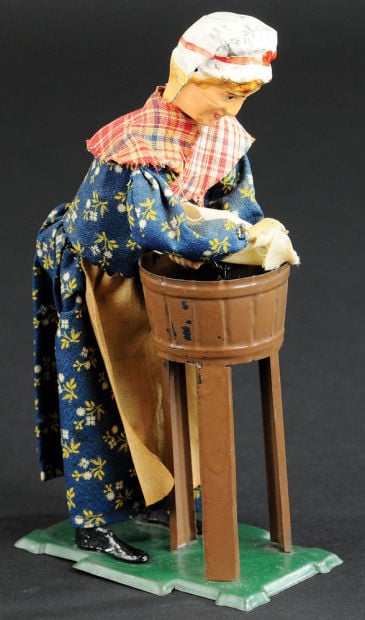Q: What can you tell me about these plates that I found at a thrift shop? Are they worth anything?
A: Indeed they are, and I’m going to invite readers to think this through with me.
Clue 1: Seen in images, the reader has several plates with a relief molded image of a potter at his wheel on the front. The relief design has a stylized, rather Deco look.
Clue 2: Solid opaque glaze colors — in this case beige and aqua — look familiar. Matter of fact, they look very like Fiesta ware.
Clue 3: Marks on the backs in black read, “Joint Exhibit of Capital and Labor.” Inside, the stamp reads, “The American Potter New York World’s Fair 1939.”
Readers, did you figure it out? The reader’s plates are souvenirs made for the 1939-1940 World’s Fair in New York by the Homer Laughlin Company. Smart collectors know HL as the maker that brought us Fiesta. That explains the similarity of glazes.
Homer Laughlin participated at the fair, as did several other china potteries. HL also made items to sell at the fair site. For 1939, commemorative items also included a 5-inch-high George Washington pitcher. Limited edition versions of the potter’s plate were also made. For 1940, souvenir ash trays were added.
The company set up a miniature working pottery in the Home Furnishings Building where every step in the dinnerware process was demonstrated.
On the up side concerning value, many collectors go for World’s Fair memorabilia. On the other hand, everyone who attended the fair had to go home with a souvenir to show friends and family where they’d been. That means that a lot of the HL plates honoring the American potter survive, and is why/how our reader found hers in a thrift shop. Good eye.
When we looked on eBay, we found many sold potter plates with results ranging from $6.99 to around $20. I suggest that our reader check them out.
FYI: “Homer Laughlin: A Giant among Dishes 1873-1939,” by Jo Cunningham (Schiffer, $29.95) tells the story of the dinnerware giant.
Q: What is the value for a document appointing my great-grandfather to an early District of Columbia governing court in 1868? It’s signed by then-president Andrew Johnson and Secretary of State William Henry Seward.
A: Most questions that we get concerning presidential signatures concern land grants. From presidential signature specialists we’ve consulted, we learned that following Andrew Jackson’s term (1829-1837), presidents did not sign routine documents. That means that Johnson, who served 1865-1869, certainly did not. Ditto for Seward.
Judicial appointments may be a different story. In this case, value depends on interest in the specific court and/or the appointee, or if the document is significant historically.
That determination calls for a specialist. In this case, Johnson’s signature may or may not be authentic and that must be determined. In any case, his signature is not that popular.
If intent is to sell, I’d photocopy the document and ask auction houses that sell books and manuscripts to take a look. If you simply want to know value, I suggest paying for a qualified appraiser who knows judicial documents.





